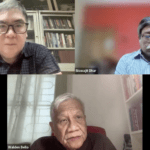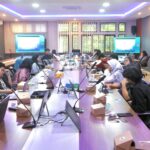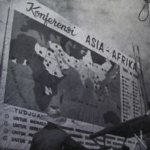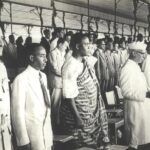by Mary Ann Manahan; originally posted on ileia.org
On Sicogon Island in the Philippines, farmers and fisher folk were displaced from their land and fisher folk were displaced from their land and livelihoods after the Typhoon Yolanda. Opportunistic land grabbing after a climate disaster is yet another example in which those least responsible for climate change suffer its gravest consequences.
Super typhoon Yolanda/Haiyan hit the Philippines in November 2013. It was the fourth strongest typhoon in recorded history. On Sicogon Island, Iloilo Province, one of the areas hardest hit by the typhoon, around 1000 farmers’ and fishers’ homes were damaged or destroyed by Yolanda. The devastation that prevailed was aggravated by internal displacement and loss of livelihoods due to land grabbing permitted by the government’s probusiness approach to reconstruction. Private companies laid claim to the land previously occupied by farmers and fisher people to develop tourism infrastructure along the coast. As the residents of the island began to rebuild their lives, they had to first reclaim their land rights.
Tourism trumps farmers
After the typhoon, President Aquino declared a 40-meter-nobuild-zone policy along the coastal zones of the country, including where people used to live. This created confusion and outrage among local governments, civil society groups, and communities affected by Yolanda who wanted to move back onto their land. On the other hand, it was the moment that Sicogon Development Corporation (SIDECO) had been waiting for, to turn Sicogon into a tourism destination.
In 2014, SIDECO entered into a joint venture partnership with the private company Ayala Land to undertake a ‘Sicogon Island Redevelopment Project’. The project was a long-standing initiative that had been accompanied by an equally long-standing land struggle for the local communities – spanning almost four decades. Before the typhoon hit, the communities’ campaign for land brought them national and international allies, including national senators, NGOs and church and human rights advocates. The Department of Agrarian Reform’s confirmation that 335 hectares of land on the island would be placed under the Comprehensive Agrarian Reform Program (CARP) was a huge feat for the communities. But the typhoon changed the balance of power in this struggle once more.
 On Sicogon Island around 1000 farmers’ and fishers’
On Sicogon Island around 1000 farmers’ and fishers’
homes were damaged or destroyed by Typhoon
Yolanda. Photo: Mary Anne Manahan
Amelia dela Cruz, a farmer leader from Sicogon Island explained how the owner of SIDECO made an opportunistic move to permanently displace people from their lands and their livelihoods. Amelia said: “SIDECO took advantage of this tragedy. Yolanda has been their ally. They gave us three options: first, they would give us Php 150,000 (approximately US$ 3000) if we would leave; second, they would relocate us to another island with free housing, water, and electricity; third, if we wouldn’t agree with any of the options, they would demolish our communities.” Some families were relocated but Amelia is amongst those who decided to stay.
Farmers and fishers stand their ground
Five months after being left homeless by Yolanda, on April 12, 2014, members of the Federation of Sicogon Island Farmers and Fisherfolk Association (FESIFFA) protested the living conditions on Sicogon Island through a camp-out in front of the Department of Environment and Natural Resources. More than 200 Sicogon families had settled in a portion of a 282-hectare public forest land area in Buaya, Sicogon as a last ditch effort to rebuild their homes and lives. FESIFFA President Raul Ramos explained: “With no options left to rebuild our communities, we were being forced by the government and by SIDECO to occupy public forest lands as a resettlement site, even without support and approval from official authorities.” Both SIDECO and its allied officials in the local Department of Environment and Natural Resources filed cases against FESIFFA farmers for their occupation of the public forest lands.
Climate justice and land grabs
The case described in this article is, unfortunately, not an unusual one. Stories of land dispossession and displacement have been repeated in the wake of many disasters caused by extreme weather events, geophysical hazards, and manmade conflicts: many New Orleans residents were displaced after Hurricane Katrina and Rita; extensive drought in Northern Sudan in the mid-1980s was the excuse to force the Hawaweer nomadic group off of their lands; after an earthquake in Pakistan and India in 2005, tenants in rural and urban areas were prohibited by landowners from re-establishing their rental rights.
These are cases of injustice in which disaster capitalism dispossesses the people living on the land. Social movements such as the one described here are crucial for reclaiming rights and livelihoods.
Source: Uson, Maria Angelina. Natural disasters and land the Hawaweer nomadic group off of their lands; grabs: the politics of their intersection in the Philippines after an earthquake in Pakistan and India in 2005, following super typhoon Haiyan. 2017. Canadian Journal tenants in rural and urban areas were prohibited of Development Studies.
Seeking support
The residents engaged in dialogues with government agencies and gathered significant public, media, and social movement support for their cause. The National Anti-Poverty Commission (NAPC), in particular, stepped in to assist in the dialogues, and provided housing for the residents. International groups, such as ICCO Cooperation, a Dutch NGO, also provided support to FESIFFA members for rebuilding their livelihoods.
Months after their camp-out, threats against them still lingered in various forms: orders to vacate the island, prohibition to repair and rebuild their houses, legal cases against them by the Department of Environment and Natural Resources for forest occupation, and legal cases against their leaders. At some point, Ayala Land stepped in and offered various packages that were unacceptable to FESIFFA.
This is not a story of defeat; Sicogon’s farmers have stayed on the island to rebuild their livelihoods
One year after Yolanda, FESIFFA members were ‘put on the spot’ to sign an alleged ‘win-win’ solution. FESIFFA, the residents of Sicogon, SIDECO, and Ayala Land signed a compromise agreement, which would allow the development of Sicogon into an eco-tourism area, on one hand, and on the other, would allow the farmers and fisher folk to continue living on the island without further harassments and intimidations by the developers. The compromise stated that FESIFFA members would be granted ‘collective titles’ to land upon forming a homeowners association. The land would be donated by SIDECO and Ayala, which meant that, in practice, the farmers with claims under the agrarian reform programme would have to withdraw them.
This compromise was perceived to be an unjust resolution by many and divided FESIFFA. It was perceived that SIDECO and Ayala Land ended up with most of the land that they wanted. And, those who had to withdraw their land claims under the agrarian reform programme would lose the rights that they had previously fought for.
Resisting and rebuilding
Nevertheless, this is not a story of defeat. Sicogon’s farmers have stayed on the island to rebuild their fishing and farming livelihoods, albeit in a limited way. None of the land reforms favouring the farmers that were agreed on in the compromise have been delivered yet, and this has motivated FESIFFA to resume its advocacy work for their land rights. In April 2017, yet again leaders went to the capital and organised a camp-out and protest in front of the Department of Environment and Natural Resources. They plan to intensify their campaign this year with renewed resolve to seek justice and secure rights to land and resources for their farming and fishing livelihoods.
Mary Ann Manahan ([email protected]) is a Senior Program Officer at Focus on the Global South.

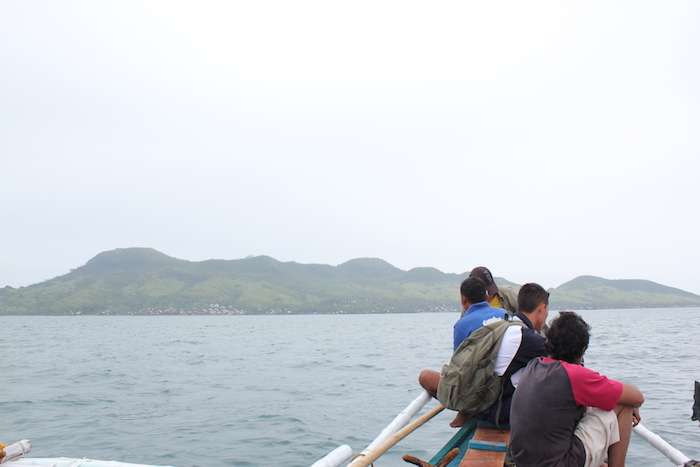
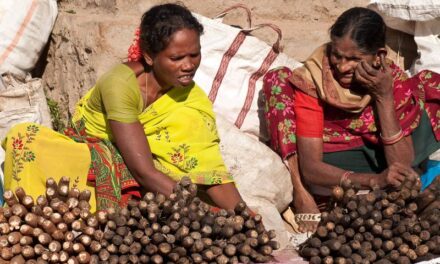

![[Analysis] Deconstructing a dismaying outcome](https://focusweb.org/wp-content/uploads/2022/05/tl-deconstructing-a-dismaying-outcome-440x264.webp)

